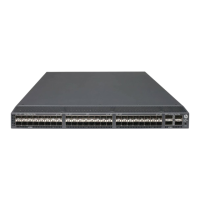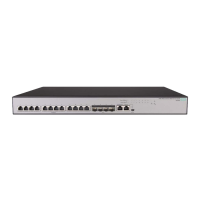116
DDNS commands
The term "interface" in this chapter collectively refers to Layer 3 interfaces, including VLAN
interfaces and Layer 3 Ethernet interfaces. You can set an Ethernet port as a Layer 3 interface by
using the port link-mode route command (see Layer 2—LAN Switching Configuration Guide).
ddns apply policy
Use ddns apply policy to apply a DDNS policy to an interface to update the mapping between the
FQDN and the primary IP address of the interface, and to enable DDNS update.
Use undo ddns apply policy to remove the application of a DDNS policy from an interface and to
stop DDNS update.
Syntax
ddns apply policy policy-name [ fqdn domain-name ]
undo ddns apply policy policy-name
Default
No DDNS policy and FQDN for update are specified on the interface, and DDNS update is disabled.
Views
Interface view
Predefined user roles
network-admin
Parameters
policy-name: Specifies the DDNS policy name, a case-insensitive string of 1 to 32 characters.
fqdn domain-name: Specifies the FQDN to replace <h> in the URL for DDNS update. The
domain-name argument specifies a case-insensitive string of 1 to 253 characters. It can include
letters, digits, hyphens (-), underscores (_), and dots (.).
Usage guidelines
You can apply up to four DDNS policies to an interface.
If you use the ddns apply policy command multiple times with the same DDNS policy name but
different FQDNs, both of the following occur:
The most recent configuration takes effect.
The device initiates a DDNS update request immediately.
Examples
# Apply the DDNS policy steven_policy to VLAN-interface 2 to update the domain name to IP
address mapping for FQDN www.whatever.com and enable DDNS update.
<Sysname> system-view
[Sysname] interface vlan-interface 2
[Sysname-Vlan-interface2] ddns apply policy steven_policy fqdn www.whatever.com
Related commands
ddns policy
display ddns policy

